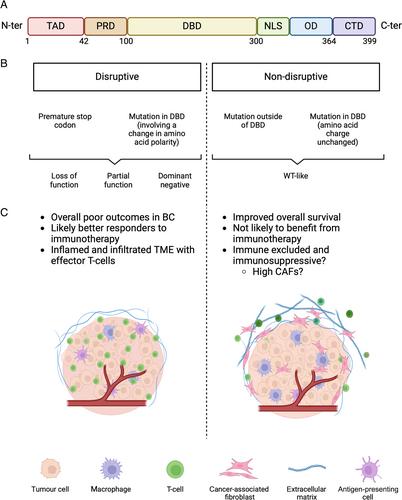下载PDF
{"title":"尿路上皮癌中的 TP53 基因突变:不尽相同†。","authors":"Alexis R Barr, Amy Burley, Anna Wilkins","doi":"10.1002/path.6335","DOIUrl":null,"url":null,"abstract":"<p>Systemic therapy options for urothelial carcinoma have expanded in recent years, with both immunotherapy and cytotoxic chemotherapy being widely available. However, we lack biomarkers to select which drug is likely to work best in individual patients. A new article in this journal by Jin, Xu, Su, <i>et al</i> reports that disruptive versus non-disruptive <i>TP53</i> mutations may guide these personalised therapy choices. Intriguingly, patients with disruptive <i>TP53</i> tumour mutations had poor overall survival versus those with non-disruptive <i>TP53</i> mutations or wild type <i>TP53</i> but responded particularly well to immunotherapy. Of relevance, an increased tumour mutational burden and increased effector CD8<sup>+</sup> T-cell infiltration was seen in tumours with disruptive mutations. The impact of different <i>TP53</i> mutations on prognosis and therapy choices appears to be tumour- and therapy-type specific, with no clear consensus on overall tumour phenotype according to type of mutation. Nonetheless, profiling of specific types of <i>TP53</i> mutation is increasingly clinically feasible with targeted sequencing or immunohistochemistry. There is an urgent need for additional studies in urothelial cancer clarifying how the type of <i>TP53</i> mutation present within a tumour can best be used as a predictive biomarker. Further important remaining questions include the impact of <i>TP53</i> mutations on other clinically important aspects of the tumour microenvironment, including cancer-associated fibroblasts. Furthermore, the impact of gain-of-function mutations in <i>TP53</i> and other related genes signalling upstream or downstream of <i>TP53</i> is of wide interest. © 2024 The Author(s). <i>The Journal of Pathology</i> published by John Wiley & Sons Ltd on behalf of The Pathological Society of Great Britain and Ireland.</p>","PeriodicalId":232,"journal":{"name":"The Journal of Pathology","volume":"264 2","pages":"125-128"},"PeriodicalIF":5.6000,"publicationDate":"2024-07-24","publicationTypes":"Journal Article","fieldsOfStudy":null,"isOpenAccess":false,"openAccessPdf":"https://onlinelibrary.wiley.com/doi/epdf/10.1002/path.6335","citationCount":"0","resultStr":"{\"title\":\"TP53 mutations in urothelial carcinoma: not all one and the same†\",\"authors\":\"Alexis R Barr, Amy Burley, Anna Wilkins\",\"doi\":\"10.1002/path.6335\",\"DOIUrl\":null,\"url\":null,\"abstract\":\"<p>Systemic therapy options for urothelial carcinoma have expanded in recent years, with both immunotherapy and cytotoxic chemotherapy being widely available. However, we lack biomarkers to select which drug is likely to work best in individual patients. A new article in this journal by Jin, Xu, Su, <i>et al</i> reports that disruptive versus non-disruptive <i>TP53</i> mutations may guide these personalised therapy choices. Intriguingly, patients with disruptive <i>TP53</i> tumour mutations had poor overall survival versus those with non-disruptive <i>TP53</i> mutations or wild type <i>TP53</i> but responded particularly well to immunotherapy. Of relevance, an increased tumour mutational burden and increased effector CD8<sup>+</sup> T-cell infiltration was seen in tumours with disruptive mutations. The impact of different <i>TP53</i> mutations on prognosis and therapy choices appears to be tumour- and therapy-type specific, with no clear consensus on overall tumour phenotype according to type of mutation. Nonetheless, profiling of specific types of <i>TP53</i> mutation is increasingly clinically feasible with targeted sequencing or immunohistochemistry. There is an urgent need for additional studies in urothelial cancer clarifying how the type of <i>TP53</i> mutation present within a tumour can best be used as a predictive biomarker. Further important remaining questions include the impact of <i>TP53</i> mutations on other clinically important aspects of the tumour microenvironment, including cancer-associated fibroblasts. Furthermore, the impact of gain-of-function mutations in <i>TP53</i> and other related genes signalling upstream or downstream of <i>TP53</i> is of wide interest. © 2024 The Author(s). <i>The Journal of Pathology</i> published by John Wiley & Sons Ltd on behalf of The Pathological Society of Great Britain and Ireland.</p>\",\"PeriodicalId\":232,\"journal\":{\"name\":\"The Journal of Pathology\",\"volume\":\"264 2\",\"pages\":\"125-128\"},\"PeriodicalIF\":5.6000,\"publicationDate\":\"2024-07-24\",\"publicationTypes\":\"Journal Article\",\"fieldsOfStudy\":null,\"isOpenAccess\":false,\"openAccessPdf\":\"https://onlinelibrary.wiley.com/doi/epdf/10.1002/path.6335\",\"citationCount\":\"0\",\"resultStr\":null,\"platform\":\"Semanticscholar\",\"paperid\":null,\"PeriodicalName\":\"The Journal of Pathology\",\"FirstCategoryId\":\"3\",\"ListUrlMain\":\"https://onlinelibrary.wiley.com/doi/10.1002/path.6335\",\"RegionNum\":2,\"RegionCategory\":\"医学\",\"ArticlePicture\":[],\"TitleCN\":null,\"AbstractTextCN\":null,\"PMCID\":null,\"EPubDate\":\"\",\"PubModel\":\"\",\"JCR\":\"Q1\",\"JCRName\":\"ONCOLOGY\",\"Score\":null,\"Total\":0}","platform":"Semanticscholar","paperid":null,"PeriodicalName":"The Journal of Pathology","FirstCategoryId":"3","ListUrlMain":"https://onlinelibrary.wiley.com/doi/10.1002/path.6335","RegionNum":2,"RegionCategory":"医学","ArticlePicture":[],"TitleCN":null,"AbstractTextCN":null,"PMCID":null,"EPubDate":"","PubModel":"","JCR":"Q1","JCRName":"ONCOLOGY","Score":null,"Total":0}
引用次数: 0
引用
批量引用


 求助内容:
求助内容: 应助结果提醒方式:
应助结果提醒方式:


